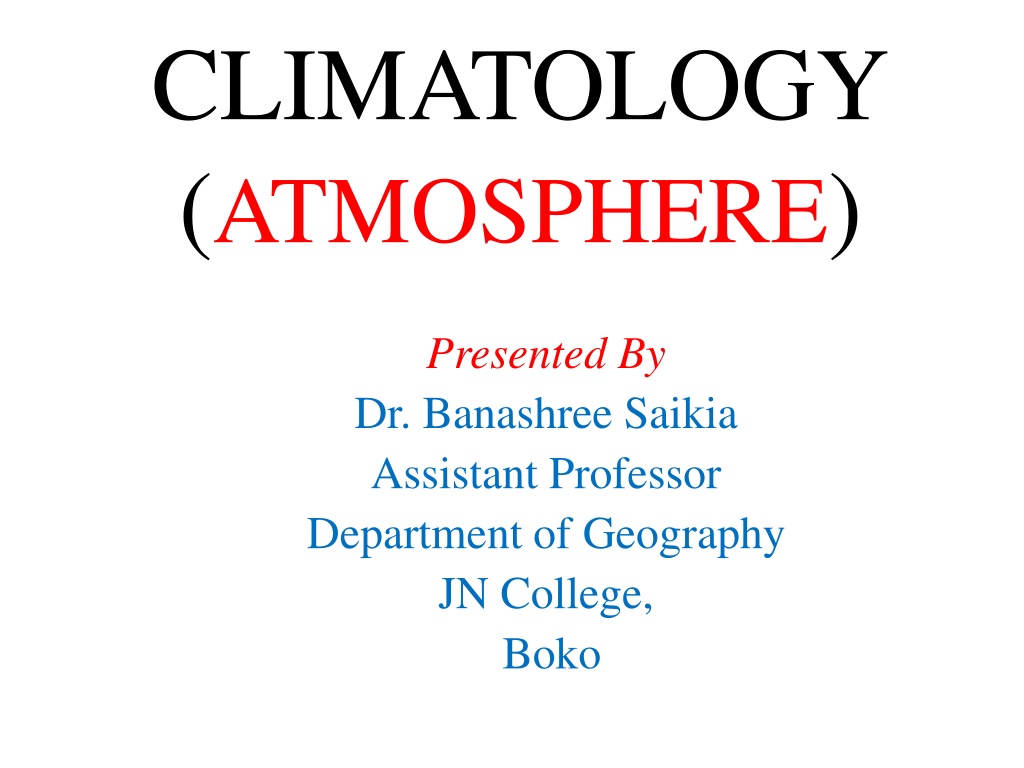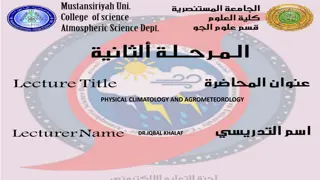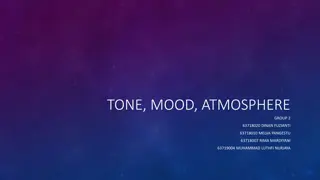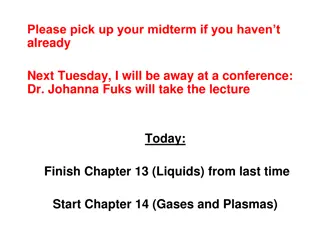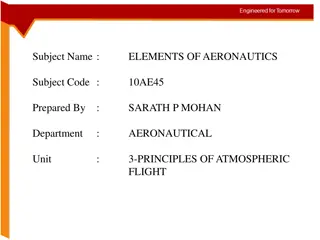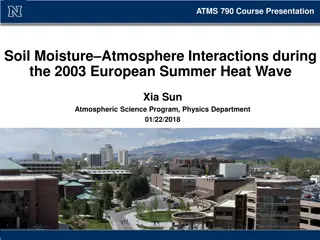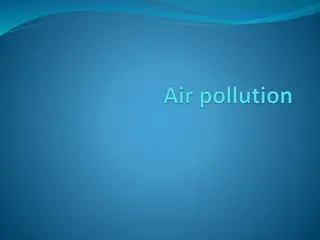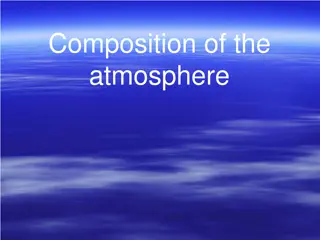Understanding Atmosphere Composition and Structure in Climatology
The study of climatology, focusing on the atmosphere, is presented by Dr. Banashree Saikia, covering topics such as atmospheric composition, insolation, temperature variations, atmospheric pressure, wind systems, atmospheric moisture, climatic classification, cyclones, and monsoons. The atmosphere, primarily composed of gases like nitrogen and oxygen, plays a crucial role in regulating Earth's temperature and protecting it from excessive solar radiation. Understanding the composition and structure of the atmosphere is essential for comprehending weather patterns and climate changes.
Download Presentation

Please find below an Image/Link to download the presentation.
The content on the website is provided AS IS for your information and personal use only. It may not be sold, licensed, or shared on other websites without obtaining consent from the author. Download presentation by click this link. If you encounter any issues during the download, it is possible that the publisher has removed the file from their server.
E N D
Presentation Transcript
CLIMATOLOGY (ATMOSPHERE) Presented By Dr. Banashree Saikia Assistant Professor Department of Geography JN College, Boko
Group A: Climatology (35 marks) (25 classes) 1. Atmospheric Composition and Structure; Variation with Altitude, Latitude and Season. (4 Classes) 2. Insolation and Temperature; Factors and Distribution and Heat Budget. (3 Classes) 3. Atmospheric Pressure and Wind system; Planetary Winds, Forces affecting Winds, General Circulation, Jet Streams. (5 Classes) 4. Atmospheric Moisture Evaporation, Humidity, Condensation, Fog, Precipitation Types, Stability and Instability. (3 Classes) 5. Climatic classification of Koppen and Trewartha. (4 Classes) 6. Cyclones and anticlyclones; Tropical Cyclones, Extra Tropical Cyclone, (3 Classes) 7. Monsoon - Origin and Mechanism.
Atmospheric Composition The atmosphere is a thick gaseous envelop which surrounds the earth from all sides and its attached to the gravitational force. Besides, atmosphere is also helpful in the sense that it filters the incoming solar radiation waves to reach the earth s surface. Thus it protects the earth from becoming too hot earth s surface by
The height of the atmosphere is estimated between 16 to 29 thousand km from sea level. But 97% of the effective atmosphere is upto the height of 29 km. The atmosphere is primarily composed of (i) Gases, (ii) Water vapour, (iii) Particulate matter
(i) Gases: Nitrogen and Oxygen are the chief components of composition of the composed 99% of the total gases in the atmosphere. The represented by Argon,Co2,neon,hellium, ozone, hydrogen, Krypton and methane the total gaseous which atmosphere remaining 1% is
Gaseous composition Gases Concentrated percentage Nitrogen 78% Oxygen 21% Argon- 0.93 CO2- 0.03% Neon- 0.0018% Helium- 0.0005% Ozone- 0.00006% Hydrogen- 0.00005% Krypton- trace Xenon- trace Methane- trace
EFFECTIVENES OF ATMOSPHERIC GASES Oxygen is essential for the survival of living beings. Carbon di oxide is used by green plants for photosynthesis. It is a green house gas and increases the temperature in the lower atmosphere and also the earth s surface. Ozone gas is helpful for absorbing most of the ultra violet rays which radiated from the sun and thus is prevents the earth from becoming too hot.
(ii) Water vapour Water vapour content in the atmosphere at a range between 0 -5 % by volume. It received in the atmosphere through the evaporation of moisture and water from the waterbodies, vegetation and soil covers. More than 90% of the total atmospheric water vapour is found upto to the height of 5km. The content of water vapour in the surface air in the moist tropical areas at 50 degree latitude (2.6%) and 70 degree latitude (0.9%). The moiture content in the atmosphere creates several forms eg: clouds,fogs, dew, rainfall, frost, hail storm, ice, snowfall etc.
(iii) Particulate matter These include mainly dust particles, salt particles,pollen smoke and volcanic ashes. These are helpful in the scattering of solar radiation which adds varied charming colour of red and orange at sunshine and sunset. Because of the scattering of solar radition by dust particles, the sky appears as blue colour. Salt particle becomes helpful in the formation of water drops, clouds, various forms of condensation and precipitation.
